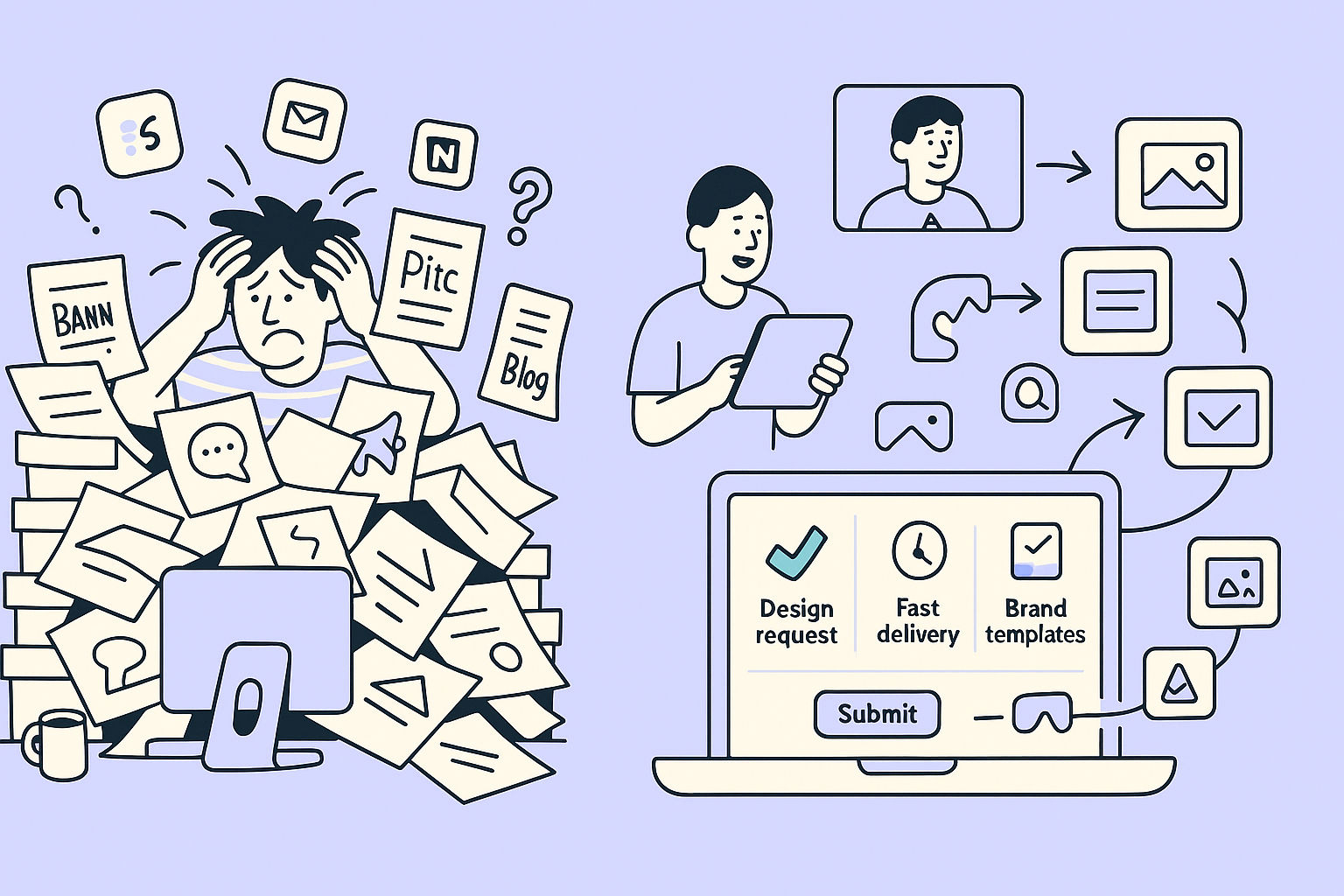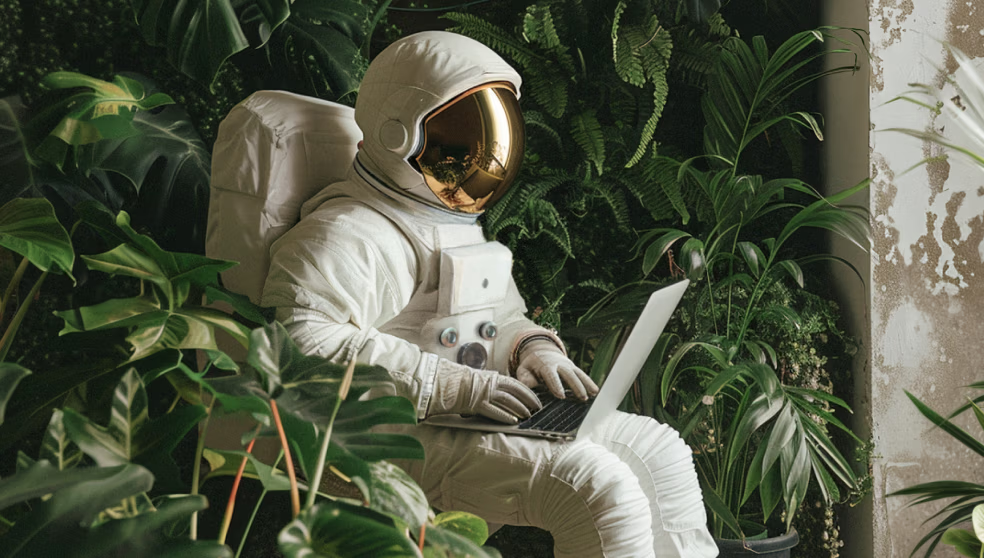
Many growing brands build an internal creative team hoping for better speed, control, and ROI. But over time, what starts as a cost-saving move becomes an expensive bottleneck. You spend more time managing creative team output and less time hitting actual growth goals.
The truth? Most internal setups are not built for scale, agility, or real business outcomes.
If you're facing missed deadlines, underwhelming campaign results, or unclear ROI you're not alone.
Let’s break down six core reasons why in-house creative team ROI often misses the mark, especially for brands scaling fast.
- 1. Creative Teams Are Overworked and Under-Prioritized
- 2. Creative Briefs Lack Clarity
- 3. Resource Management Is a Full-Time Job
- 4. In-House vs. External ROI Isn't Always Clear
- 5. Scalability Is Limited by People, Not Process
- 6. Measuring ROI Is an Afterthought
- How Aneeverse Helps You Scale Creative with ROI in Mind
- Conclusion: You Don’t Need More Designers. You Need Better Systems.
1. Creative Teams Are Overworked and Under-Prioritized
A full-time in-house creative team sounds like the dream. You have designers, writers, editors all sitting close to your product and brand.
But in most companies, the dream doesn’t match the reality.
The in-house marketing team performance often struggles because the creative team is stretched across too many tasks. On Monday, they’re building a pitch deck. On Tuesday, they’re redesigning a landing page. By Wednesday, they’re editing a blog, answering Slack messages, and making last-minute banners for a webinar.
And it never stops.
This always-on demand leads to three core issues:
1.1 No Time for High-Impact Work
Your team wants to do great work. But they’re stuck in “reaction mode.” That means:
- No time for planning
- No time for testing what works
- No time for improving existing creatives
The focus shifts from quality to speed. And fast doesn’t always mean effective.
In the long run, this hurts in-house creative team ROI. The team is busy, but the results are unclear. It’s hard to measure what actually works when the team is only reacting.
1.2 Burnout from Task-Switching
One designer may handle 5–6 types of requests a day: a carousel post, a website update, an internal newsletter banner, and a client pitch deck.
That constant context-switching drains energy and lowers focus.
Most in-house agency challenges begin here. Talented people lose their creative edge because they’re too tired to think deeply. It’s not a skill problem. It’s a system problem.
Without clear goals, your team will always be working but not always moving the needle.
1.3 Delays and Bottlenecks Everywhere
When there are too many tasks and no prioritization, even simple projects slow down. Content calendars fall behind. Landing pages miss launch dates. Design feedback loops stretch for weeks.
This delay means your in-house content production challenges pile up fast. Marketing plans fall apart. Sales teams build their own ugly slides. Product updates launch without proper visuals.
And worst of all? No one takes ownership because everyone is just “trying to keep up.”
If your team is stuck in this mode, the problem isn’t talent it’s structure. You're not getting full value from the people you’ve hired. That’s a direct hit to your in-house creative team ROI.
1.4 Your Budget Looks Spent But the Work Feels Incomplete
Many marketing leaders feel this pain. They spend thousands on in-house salaries. But when they look at output, it feels inconsistent.
Where are the high-converting pages?
Where are the great campaigns?
Where’s the momentum?
It’s not because your team isn’t good. It’s because they’re not supported with the right processes, systems, or time. Most internal creative team scalability problems start here trying to do everything with no time to do anything well.
2. Creative Briefs Lack Clarity
One of the biggest in-house agency challenges is not the work itself it’s the way work is requested.
Most creative problems start with unclear inputs. When a designer or writer gets a vague request like “Make it pop” or “We just need something fast,” the result is slow, off-brand, or ineffective.
That’s not a creative problem. That’s a planning problem.
2.1 Vague Briefs = Vague Results
If your brief doesn’t clearly say what the asset is for, who it’s for, or what it needs to achieve, the creative team is forced to guess. And when they guess, you lose time on revisions.
This leads to in-house content production challenges like:
- Confusing messaging
- Mismatched tone
- Endless edits
- Work that looks good, but doesn’t perform
A poor brief makes even the best talent struggle.

2.2 No Shared Metrics = No Shared Direction
Most in-house marketing team performance problems are made worse by disconnected goals.
For example:
- Marketing wants leads
- Sales wants faster demos
- Product wants a better onboarding flow
But if none of those goals are clear in the creative brief, the team ends up building “something” without knowing if it’s the right thing.
You can’t measure in-house creative team ROI if you’re not clear on what “success” looks like from the start.
2.3 Different Teams, Different Requests No Central Workflow
In many companies, marketing, sales, and product all make design or content requests. But without a single system, those requests come in via Slack, email, Asana, or meetings all at once.
No one knows:
- Which task matters most
- What’s due when
- Who owns approvals
This kind of workflow chaos drains time and causes friction between teams.
The result?
Late assets. Duplicated work. Missed opportunities.
Without a shared system and a clear brief format, your in-house agency resource management will always suffer. The team becomes reactive, not strategic. They stay busy, but never feel focused.
3. Resource Management Is a Full-Time Job
Creating content takes time. Managing a team that creates content takes even more. But many in-house teams don’t have proper systems in place to manage projects from idea to delivery.
If your internal creative team doesn’t have a dedicated project manager, clear timelines, and visibility into workloads, things quickly fall apart. Designers get double-booked. Writers rush through copy. Marketers wait too long for assets. Work becomes reactive instead of strategic.
This kind of poor in-house agency resource management leads to:
- Missed deadlines
- Low creative quality
- Wasted time in endless back-and-forth
- Projects that drag on without clear owners
It’s not about team size. Even a small team can move fast when there’s structure. What matters is having the right tools and systems to keep everyone aligned and focused.
That’s why many growing brands partner with teams like Aneeverse. We help creative teams build strong processes: clear request flows, real-time status tracking, and simple project dashboards. So your team can stop reacting and start delivering.
When your internal team is supported by smart systems, your in-house creative team ROI improves across the board.
4. In-House vs. External ROI Isn't Always Clear

Most companies believe that hiring internally saves money. But when it comes to long-term performance, the comparison between an in-house agency vs. external ROI often reveals hidden costs.
At first glance, an in-house team feels cheaper. You pay fixed salaries and keep everything under one roof. But dig a little deeper and things start to shift. Internal teams hit limits on time, tools, and creative variety. That’s when bottlenecks begin.
Let’s look at a basic comparison:
| Criteria | In-House Agency | Aneeverse |
|---|---|---|
| Cost | Fixed salaries + overhead | Flexible pricing per output |
| Speed | Limited by bandwidth | Dedicated creative queue |
| Creative Direction | Strong brand familiarity | External expertise + fast alignment |
| Scalability | Requires hiring + training | Scale instantly with experienced teams |
Many brands measure in-house creative team ROI by cost per asset. But that’s only part of the picture. What matters more is speed, creative flexibility, and campaign performance.
At Aneeverse, we work with marketing teams that already have internal talent. They don’t want to replace them they want to support them. Our model blends in easily, providing fast creative output without the hiring lag.
If your internal team is swamped, or your growth plans outpace your design bandwidth, an external partner can boost ROI without bloating your headcount.
5. Scalability Is Limited by People, Not Process
Internal teams often scale in a straight line. More design requests? Add more designers. But that model gets expensive and slow fast.
Internal creative team scalability shouldn’t depend on constant hiring. It should be systems-driven.
Here’s where cracks appear:
- Every new hire takes weeks (or months) to recruit, onboard, and train.
- Specialized skills like motion graphics, UX writing, or landing page UX aren’t always available in-house.
- Even when you outsource to freelancers, someone still needs to manage them, which adds more internal pressure.
Meanwhile, demand keeps rising. Paid ads need multiple versions. Website banners need frequent updates. Blog visuals, social posts, sales decks they all pile up.
That’s why traditional team models break under creative pressure. It’s not about talent it’s about scale.
At Aneeverse, we help marketing teams scale without hiring. Our design subscription model gives you a ready-to-go system: fast creative delivery, flexible queues, and expert skills on demand. You get the output you need, without burning out your in-house team.
Smart scalability means building systems, not just adding headcount.
6. Measuring ROI Is an Afterthought
Let’s be honest. Most internal teams are measured by volume, not results.
Designers ship banners. Writers publish posts. Marketers launch ads. Then… on to the next task.
But in-house marketing team performance should connect directly to business outcomes not just output. Without that link, you’re not doing performance marketing. You’re just producing assets.
Ask yourself:
- Did that landing page drive signups or just look good?
- Did your social post actually increase engagement or just fill the content calendar?
- Did the paid creative lead to demos, or just impressions?
Most teams don’t know. And that’s where in-house content production challenges quietly block growth. Without visibility, you can’t improve you can only guess.
That’s why creative operations matter. You need tools, systems, and workflows that tie output to impact.
At Aneeverse, we help teams build those systems. From content tracking dashboards to campaign-level performance reports, we give brands the clarity they need to scale not just the creatives.
When you stop tracking effort and start tracking results, everything changes.

How Aneeverse Helps You Scale Creative with ROI in Mind
At Aneeverse, we help brands move fast without sacrificing quality or ROI.
Instead of hiring more designers or chasing freelancers, our design subscription model gives you:
- A dedicated design queue
- Fast async delivery
- Brand-aligned templates and systems
- Fixed pricing for predictable costs
We help solve in-house agency challenges by acting as your creative extension no hiring, no delays, no micromanagement.
If your in-house creative team ROI is dropping, let us show you a system that scales.
Conclusion: You Don’t Need More Designers. You Need Better Systems.
Most internal teams fail not because of talent, but because of structure. Without the right workflows, tools, and priorities, even the best creatives can’t drive real results.
If your team is feeling the strain or if your creative output isn’t matching business goals it’s time to rethink the model.
A smarter system always beats more headcount.

Custom video production at scale
Aneeverse covers all video needs whether you're telling your brand story, launching a product or running ads. Discover how we can help you scale.
